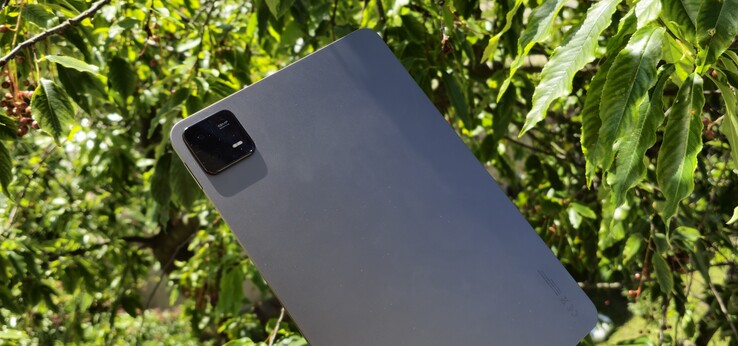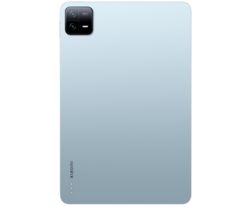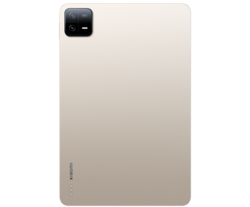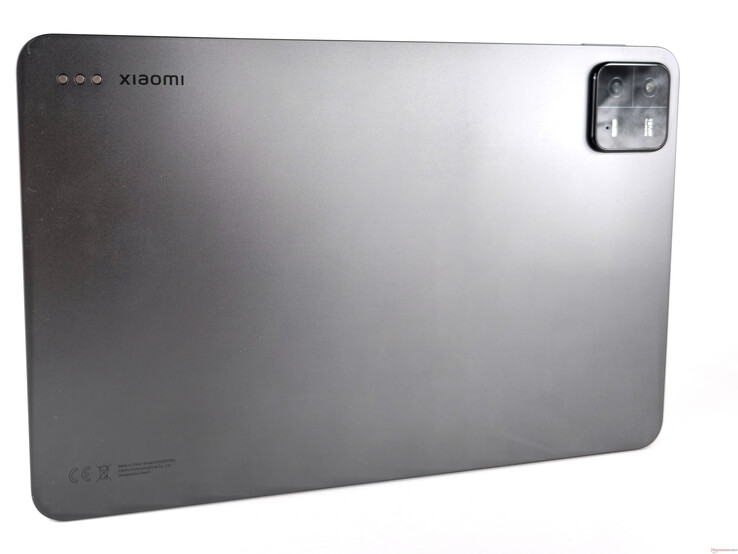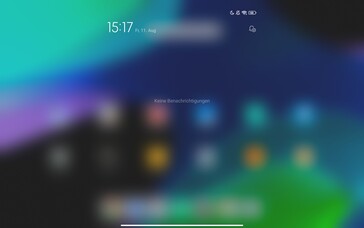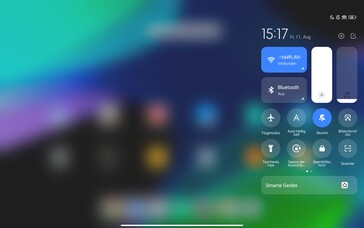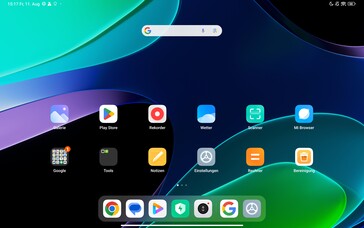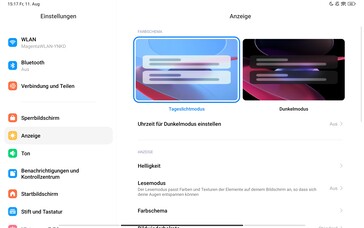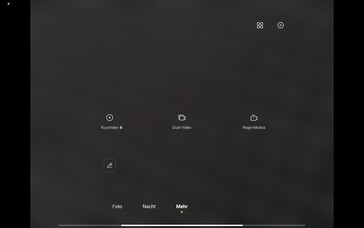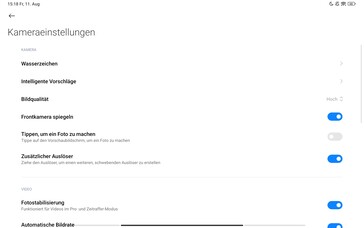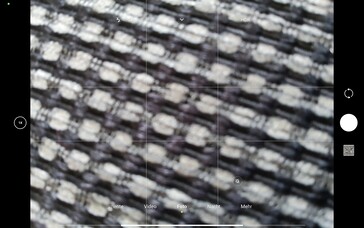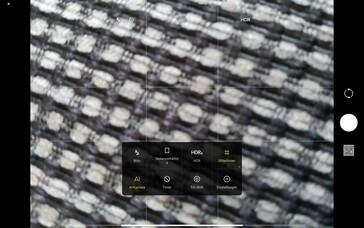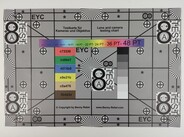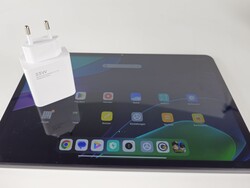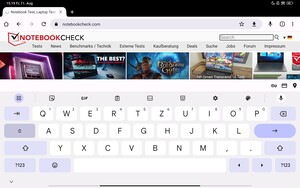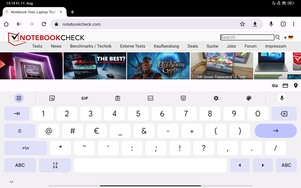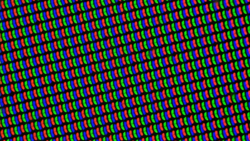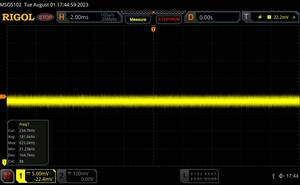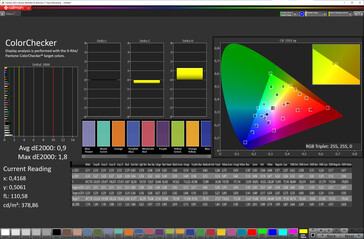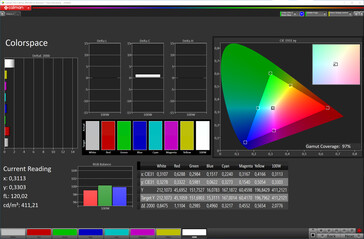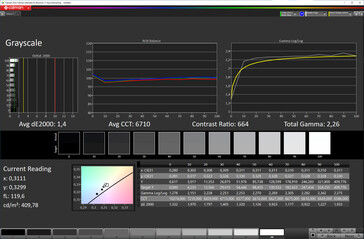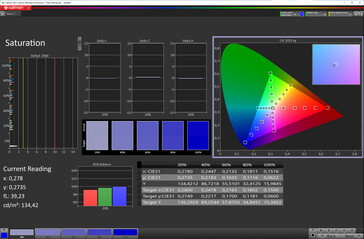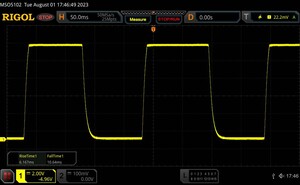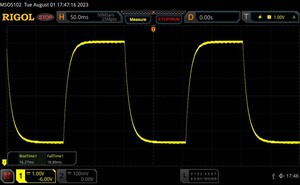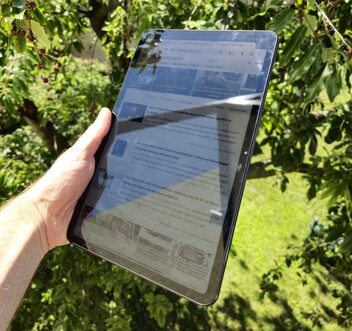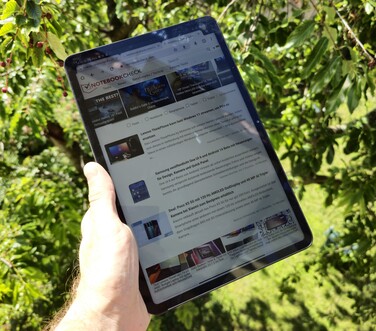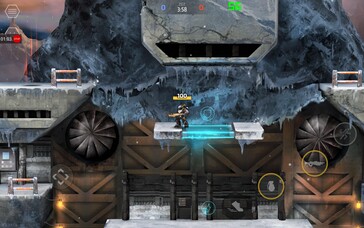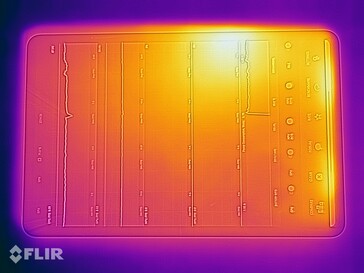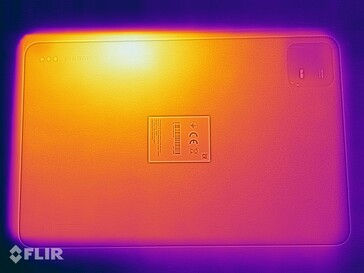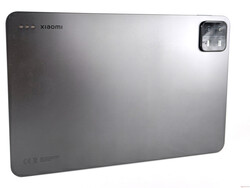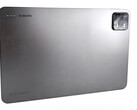Xiaomi Pad 6 review: Massively improved tablet with stylus support at the same affordable price
After a one-year hiatus, Xiaomi is now introducing the next generation of its tablet series to the market. Despite numerous improvements compared to the predecessor, the MSRP of 399 Euros (~$434) for the entry-level version (6 GB, 128 GB) remains unchanged. Those who can invest 100 Euros (~$109) more get additional storage with 8 GB RAM and 256 GB UFS 3.1.
Not only does the Xiaomi Pad 6 inherit the Snapdragon 870 of the previous Pro version but also its WiFi 6 compatibility. The battery of the new midrange tablet from Xiaomi offers a capacity of 8,840 mAh and can be charged at up to 33 watts. This is accompanied by an 11-inch LCD screen with a resolution of 2,880 x 1,800 pixels. Compared to the Pad 5, both the pixel density of 309 PPI and also the refresh rate of 144 Hz have increased.
Possible Competitors in Comparison
Rating | Date | Model | Weight | Height | Size | Resolution | Price |
|---|---|---|---|---|---|---|---|
| 88.8 % v7 (old) | 08 / 2023 | Xiaomi Pad 6 SD 870, Adreno 650 | 490 g | 6.51 mm | 11.00" | 2880x1800 | |
| 87.6 % v7 (old) | 12 / 2021 | Xiaomi Pad 5 SD 860, Adreno 640 | 511 g | 6.85 mm | 11.00" | 2560x1600 | |
| 89.3 % v7 (old) | 04 / 2023 | OnePlus Pad Dimensity 9000, Mali-G710 MP10 | 552 g | 6.5 mm | 11.61" | 2800x2000 | |
| 82.4 % v7 (old) | 04 / 2023 | Lenovo Tab P11 (Gen 2) Helio G99, Mali-G57 MP2 | 520 g | 7.4 mm | 11.50" | 2000x1200 | |
| 84.6 % v7 (old) | 12 / 2022 | Xiaomi Redmi Pad Helio G99, Mali-G57 MP2 | 445 g | 7.05 mm | 10.61" | 2000x1200 | |
| 83.1 % v7 (old) | 01 / 2023 | Oppo Pad Air SD 680, Adreno 610 | 440 g | 6.9 mm | 10.36" | 2000x1200 |
Case - Xiaomi Pad 6 with high-quality looks
Compared to the previous generation, the Xiaomi Pad 6 includes numerous improvements, starting from the design and choice of materials. The midrange tablet from Xiaomi now offers high-quality haptics with its uni-body design in contrast to a plastic back as in the Pad 5. The metal case can be purchased in the three color options of black, blue, and gold. Thanks to its matte surface, fingerprints won't become a problem with the Xiaomi Pad 6.
Not only did the 2023 Xiaomi tablet become slightly more compact, which is reflected in the better screen-to-surface ratio of now 83.6% of the IPS panel in the front, but at 490 grams (~1.08 lb), it is also lighter than its predecessor. In addition, the front of the Xiaomi Pad 6 is protected by Corning Gorilla Glass 3. However, the case doesn't offer an official IP certification, so you shouldn't use the Xiaomi tablet in the rain.
Interestingly, the slot for a SIM card can be seen milled into the frame, even though you cannot insert any card into the Xiaomi Pad 6, so the midrange tablet and its corresponding Pro model that supports 5G appear to share the same case.
Equipment - Xiaom tablet with USB 3.2
With its new tablet generation, Xiaomi remedies one of the largest critique points of the Pad 5, and the slow USB 2.0 standard is replaced in the Xiaomi Pad 6 with a USB 3.2 connection (Gen 1). This allows data transfer of up to 5 Gbit/s, assuming you have the corresponding capabilities on the other end. The included USB cable doesn't support data transfer via USB 3.0, so buyers of the Pad 6 still have to invest some more money after their purchase. Using an adapter, the port can also be used as a display output to connect external displays. In our copy test using a connected M2 SSD drive (Samsung 980 Pro), the USB port achieves solid transfer rates of 290.4 MB/s.
The USB connection also supports OTG, allowing you to connect external peripheral devices or storage media. In addition, Miracast is available for wireless transfer to external monitors.
Software - Xiaomi Pad 6 with Android 13
As the operating system, Xiaomi has installed its inhouse MIUI for Pad 14 user interface, which is based on Android 13. During our test period, the system of the midrange tablet uses the security patch level of July 2023. Thanks to the DRM L1 certification, you can watch streaming contents in high resolution on the large 11-inch LCD display.
At this point, there is no update warranty for the tablet segment as in the global Xiaomi smartphones of the premium price range. However, the Xiaomi Security Center lists the Pad 6 also with the future Android 14 and Android 15 versions. There are supposed to be quarterly security updates, but Xiaomi doesn't mention anything about the official support period. Midrange smartphones of this price range from the manufacturer offer between three and four year support periods here.
Communication and GNSS - Xiaomi tablet without GPS
In contrast to its predecessor, the Xiaomi Pad 6 offers fairly fast WiFi 6, although it is unable to create a connection with the 6-Gigahertz frequency band for WLAN transfers. In combination with the Asus ROG Rapture GT-AXE11000 router, the Xiaomi tablet reaches transfer rates with peaks above 900 Mbit/s, which is a good value in the price range of the Pad 6.
The tablet from Xiaomi doesn't offer an NFC chip for contactless payment, but instead Bluetooth 5.2 and four microphones for video calling over WLAN are included. LTE or 5G frequencies are not supported by the Xiaomi tablet, and neither is a GPS module.
Similar to Samsung's auto framing technology, Xiaomi implements a centering function in the Pad 6, which is supposed to ensure that the user always remains in the center of the image during video calls, even when moving. If a second person also joins in, the field of view is enlarged correspondingly. However, this feature doesn't work with all applications. Our test call using Skype reveals a front camera that uses a very wide angle but with a fixed viewing angle.
| Networking | |
| Xiaomi Pad 6 | |
| iperf3 receive AXE11000 | |
| iperf3 transmit AXE11000 | |
| Xiaomi Pad 5 | |
| iperf3 transmit AX12 | |
| iperf3 receive AX12 | |
| OnePlus Pad | |
| iperf3 receive AXE11000 | |
| iperf3 transmit AXE11000 | |
| Lenovo Tab P11 (Gen 2) | |
| iperf3 receive AXE11000 | |
| iperf3 transmit AXE11000 | |
| Xiaomi Redmi Pad | |
| iperf3 receive AXE11000 | |
| iperf3 transmit AXE11000 | |
| Oppo Pad Air | |
| iperf3 receive AXE11000 | |
| iperf3 transmit AXE11000 | |
Cameras - Xiaomi Pad 6 with a single camera
The spec sheet for the cameras of the Xiaomi Pad 6 doesn't mention any changes compared to the predecessor. Above the display, the 11-inch tablet continues to offer an 8-MP front camera with an f/2.2 aperture that delivers very acceptable results in daylight conditions and a good quality for video calls. Those who like to send short video messages are able to do this in a resolution of 1080p.
The 13-MP main camera in the back allows recording videos in maximum UHD quality at 30 fps. With sufficient light, the sensor with an aperture of f/2.2 delivers an attractive image quality. The color reproduction, detail, and dynamic extension of the images are definitely sufficient for some snapshots, even if users of an 11-inch tablet would probably want to use the camera module in the back more to record documents or notes. The camera app also offers a special mode for this.
Image comparison
Choose a scene and navigate within the first image. One click changes the position on touchscreens. One click on the zoomed-in image opens the original in a new window. The first image shows the scaled photograph of the test device.
HauptkameraHauptkameraLow LightZoom 5xWe take a more detailed look of the color accuracy of the 13-MP sensor under controlled light conditions. The deviations of the reference colors we find are free from any real outliers (>15), and most colors are reproduced accurately. However, the color reproduction is slightly too bright in general, and the white balance is calibrated slightly too warm.
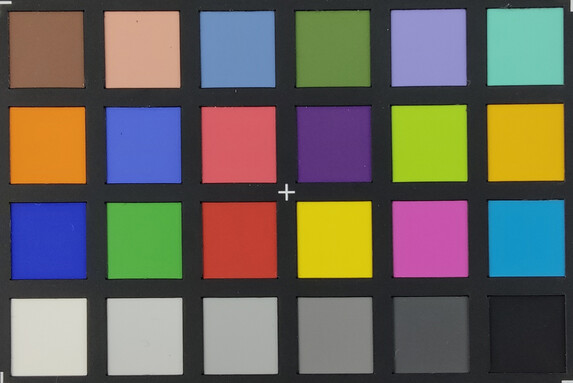
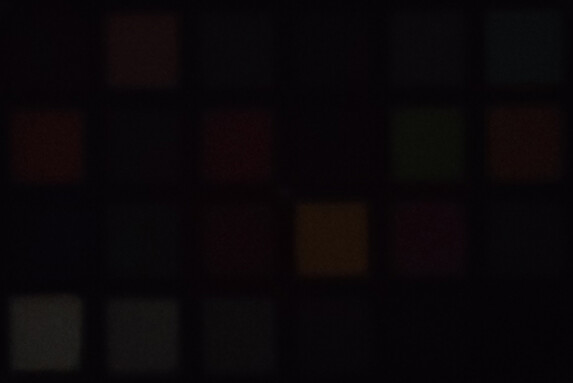
Accessories and Warranty - Xiaomi tablet with included charger
The box of the midrange tablet includes a modular 33-Watt charger and a USB cable (2.0 standard). In addition, Xiaomi offers a compatible Smart Pen of the 2nd generation with 4,096 pressure levels and a battery life of up to 150 hours as an additional accessory for the Pad 6 at an MSRP of around 100 Euros (~$109). An optional keyboard cover is also available for around 90 Euros (~$98).
Xiaomi offers a warranty period of 24 months for its tablet in Germany.
Input Devices and Operation - Xiaomi Pad 6 without a fingerprint sensor
The 11-inch IPS panel with its Gorilla Glass 3 covering implements finger inputs quickly and precisely. Thanks to its refresh rate of 144 Hz, scrolling gestures in the browser or GUI animations are displayed very smoothly. Unfortunately, we are unable to test how the Xiaomi Pad 6 fares in everyday operation with the 13-gram (~0.45 oz) Smart Pen 2. The manufacturer doesn't specify any information on the latency.
The current Xiaomi Pad generation still doesn't offer a fingerprint scanner. The front camera allows unlocking via biometric face recognition for a maximum of two stored faces. Both the response speed and recognition rates of the fairly insecure 2D face recognition are convincing in daylight conditions, but with less light and dimmed display, this won't work as reliably. For compatible Xiaomi wearables or smartphones, there is also a smart unlocking function via "trusted devices."
Display - Xiaomi tablet with IPS panel
The 11-inch LCD panel offers a slightly unusual resolution of 2,880 x 1,800 pixels with a maximum refresh rate of up to 144 Hz. To save power, the system is also able to optionally adjust the refresh rate automatically (144 Hz, 90 Hz, 60 Hz) - we can gather these values from the system information. Interestingly, the refresh rate is reduced to 50 Hz after a short period without any finger inputs, even when it is fixed at 144 Hz. The screen uses an RGB matrix consisting of one red, one blue, and one green LED each.
According to the manufacturer, a maximum brightness of 550 nits is supposed to be reached, and we can also confirm this from our measurements in the APL18 test with 543 cd/m². With a pure white display and activated brightness sensor, the display of the Xiaomi Pad 6 reaches almost 500 cd/m² on average, which is also a good value for this price class while still insufficient for optimal display of HDR material.
We cannot detect any flickering from PWM in the LCD panel, so the Xiaomi tablet should be particularly suited for users who are sensitive to PWM.
| |||||||||||||||||||||||||
Brightness Distribution: 89 %
Center on Battery: 541 cd/m²
Contrast: 832:1 (Black: 0.65 cd/m²)
ΔE ColorChecker Calman: 0.9 | ∀{0.5-29.43 Ø4.77}
ΔE Greyscale Calman: 1.4 | ∀{0.09-98 Ø5}
97% sRGB (Calman 2D)
Gamma: 2.26
CCT: 6710 K
| Xiaomi Pad 6 IPS LCD, 2880x1800, 11" | Xiaomi Pad 5 IPS, 2560x1600, 11" | OnePlus Pad IPS, 2800x2000, 11.6" | Lenovo Tab P11 (Gen 2) IPS, 2000x1200, 11.5" | Xiaomi Redmi Pad IPS, 2000x1200, 10.6" | Oppo Pad Air IPS, 2000x1200, 10.4" | |
|---|---|---|---|---|---|---|
| Screen | -54% | -53% | -153% | -53% | -144% | |
| Brightness middle (cd/m²) | 541 | 491 -9% | 474 -12% | 423 -22% | 418 -23% | 352 -35% |
| Brightness (cd/m²) | 494 | 473 -4% | 447 -10% | 396 -20% | 402 -19% | 339 -31% |
| Brightness Distribution (%) | 89 | 91 2% | 89 0% | 88 -1% | 90 1% | 85 -4% |
| Black Level * (cd/m²) | 0.65 | 0.87 -34% | 0.32 51% | 0.29 55% | 0.28 57% | 0.45 31% |
| Contrast (:1) | 832 | 564 -32% | 1481 78% | 1459 75% | 1493 79% | 782 -6% |
| Colorchecker dE 2000 * | 0.9 | 1.9 -111% | 3.16 -251% | 5.32 -491% | 2.3 -156% | 4.79 -432% |
| Colorchecker dE 2000 max. * | 1.8 | 4.1 -128% | 5.37 -198% | 9.87 -448% | 5.4 -200% | 8.65 -381% |
| Greyscale dE 2000 * | 1.4 | 3 -114% | 2.5 -79% | 6.6 -371% | 3.7 -164% | 5.5 -293% |
| Gamma | 2.26 97% | 2.21 100% | 2.09 105% | 2.159 102% | 2.21 100% | 2.118 104% |
| CCT | 6710 97% | 7182 91% | 7112 91% | 7979 81% | 6595 99% | 7889 82% |
* ... smaller is better
Screen Flickering / PWM (Pulse-Width Modulation)
| Screen flickering / PWM detected | 181600 Hz | ||
The display backlight flickers at 181600 Hz (worst case, e.g., utilizing PWM) . The frequency of 181600 Hz is quite high, so most users sensitive to PWM should not notice any flickering. In comparison: 53 % of all tested devices do not use PWM to dim the display. If PWM was detected, an average of 8081 (minimum: 5 - maximum: 343500) Hz was measured. | |||
One of the weaknesses of the Xiaomi Pad 5 was the low contrast of the LCD panel. The successor is now supposed to improve this, and Xiaomi specifies a value of 1400:1. However, with the fairly high black value of 0.65 cd/m², we are unable to confirm this pronounced contrast ratio, even though at 830:1, the Xiaomi Pad 6 is still improved compared to the predecessor in this regard.
We evaluate the color calibration of the HDR10-certified IPS panel with the Calman analysis software and a photo spectrometer. The "Original Pro" profile targets the sRGB color space, which is covered almost completely. We see very low color deviations, and the DeltaE values we measure show very small deviations in the grayscale. The Xiaomi Pad 6 also offers two additional color profiles as well as the option to target the larger DCI-P3 color space. But as we expected, the deviations in the color reproduction turn out slightly higher here.
In addition, the extended settings allow you to adjust the color space and color temperature, as well as individual parameters such as the saturation. Optionally, the brightness sensor is also able to adjust the color reproduction automatically depending on the light conditions.
Display Response Times
| ↔ Response Time Black to White | ||
|---|---|---|
| 16.81 ms ... rise ↗ and fall ↘ combined | ↗ 6.167 ms rise | |
| ↘ 10.64 ms fall | ||
| The screen shows good response rates in our tests, but may be too slow for competitive gamers. In comparison, all tested devices range from 0.1 (minimum) to 240 (maximum) ms. » 38 % of all devices are better. This means that the measured response time is better than the average of all tested devices (20.2 ms). | ||
| ↔ Response Time 50% Grey to 80% Grey | ||
| 35.16 ms ... rise ↗ and fall ↘ combined | ↗ 16.27 ms rise | |
| ↘ 18.89 ms fall | ||
| The screen shows slow response rates in our tests and will be unsatisfactory for gamers. In comparison, all tested devices range from 0.165 (minimum) to 636 (maximum) ms. » 48 % of all devices are better. This means that the measured response time is worse than the average of all tested devices (31.6 ms). | ||
Outdoors, the midrange tablet leaves a good impression. Even though the brightness is unable to compensate reflections in bright sunlight, you can still read the contents of the LCD display in partial shade. The stability of the viewing angles is also very attractive, and even from steep viewing angles, the brightness drops only marginally.
Performance - Xiaomi Pad 6 with Qualcomm SoC
The Qualcomm Snapdragon 870 SoC used in the Xiaomi Tab 6 integrates eight cores that are distributed into three clusters. The fastest Cortex A77 core reaches up to 3.2 GHz, the performance cluster with three Cortex A77 cores up to 2.42 GHz, and the power-saving cluster with four efficient Cortex A55 cores up to 1.8 GHz. An Adreno 650 is used as the graphics card.
While the system speed is very good, we still see some small system stutters from time to time. The results in our benchmark measurements are at an attractive level, even if the OnePlus Pad with the Dimensity 9000 delivers a higher performance. Compared to the predecessor, the Xiaomi Pad 6 brings an approximately 20% increase in the Geekbench results.
| UL Procyon AI Inference for Android - Overall Score NNAPI | |
| OnePlus Pad | |
| Average of class Tablet (2597 - 76852, n=61, last 2 years) | |
| Xiaomi Pad 6 | |
| Average Qualcomm Snapdragon 870 5G (12855 - 18000, n=8) | |
| Lenovo Tab P11 (Gen 2) | |
| Xiaomi Redmi Pad | |
In the graphics tests of 3DMark, the performance differences between the Xiaomi Pad 6 and the OnePlus Pad become even clearer, and in the GFXBench measurements, the differences between both tablets are 50% at times. As expected due to its lower resolution, the Xiaomi Pad 5 is able to keep up with the Adreno 650 in the successor in terms of the onscreen values.
GFXBench (DX / GLBenchmark) 2.7: T-Rex Onscreen | 1920x1080 T-Rex Offscreen
GFXBench 3.0: on screen Manhattan Onscreen OGL | 1920x1080 1080p Manhattan Offscreen
GFXBench 3.1: on screen Manhattan ES 3.1 Onscreen | 1920x1080 Manhattan ES 3.1 Offscreen
GFXBench: on screen Car Chase Onscreen | 1920x1080 Car Chase Offscreen | on screen Aztec Ruins High Tier Onscreen | 2560x1440 Aztec Ruins High Tier Offscreen | on screen Aztec Ruins Normal Tier Onscreen | 1920x1080 Aztec Ruins Normal Tier Offscreen | 3840x2160 4K Aztec Ruins High Tier Offscreen
| 3DMark / Wild Life Extreme Unlimited | |
| OnePlus Pad | |
| Xiaomi Pad 6 | |
| Xiaomi Pad 5 | |
| Lenovo Tab P11 (Gen 2) | |
| Xiaomi Redmi Pad | |
| Oppo Pad Air | |
| 3DMark / Wild Life Extreme | |
| OnePlus Pad | |
| Xiaomi Pad 6 | |
| Xiaomi Pad 5 | |
| Xiaomi Redmi Pad | |
| Lenovo Tab P11 (Gen 2) | |
| Oppo Pad Air | |
| 3DMark / Wild Life Unlimited Score | |
| OnePlus Pad | |
| Xiaomi Pad 6 | |
| Xiaomi Pad 5 | |
| Xiaomi Redmi Pad | |
| Lenovo Tab P11 (Gen 2) | |
| Oppo Pad Air | |
| 3DMark / Wild Life Score | |
| OnePlus Pad | |
| Xiaomi Pad 6 | |
| Xiaomi Pad 5 | |
| Lenovo Tab P11 (Gen 2) | |
| Xiaomi Redmi Pad | |
| Oppo Pad Air | |
| 3DMark / Sling Shot Extreme (ES 3.1) Unlimited | |
| OnePlus Pad | |
| Xiaomi Pad 6 | |
| Xiaomi Pad 5 | |
| Xiaomi Redmi Pad | |
| Oppo Pad Air | |
| 3DMark / Sling Shot Extreme (ES 3.1) Unlimited Graphics | |
| OnePlus Pad | |
| Xiaomi Pad 6 | |
| Xiaomi Pad 5 | |
| Xiaomi Redmi Pad | |
| Oppo Pad Air | |
| 3DMark / Sling Shot Extreme (ES 3.1) Unlimited Physics | |
| OnePlus Pad | |
| Xiaomi Pad 6 | |
| Xiaomi Pad 5 | |
| Xiaomi Redmi Pad | |
| Oppo Pad Air | |
| GFXBench (DX / GLBenchmark) 2.7 / T-Rex Onscreen | |
| Xiaomi Pad 5 | |
| Xiaomi Pad 6 | |
| OnePlus Pad | |
| Lenovo Tab P11 (Gen 2) | |
| Xiaomi Redmi Pad | |
| GFXBench (DX / GLBenchmark) 2.7 / T-Rex Offscreen | |
| OnePlus Pad | |
| Xiaomi Pad 5 | |
| Xiaomi Pad 6 | |
| Lenovo Tab P11 (Gen 2) | |
| Xiaomi Redmi Pad | |
| GFXBench 3.0 / Manhattan Onscreen OGL | |
| Xiaomi Pad 5 | |
| OnePlus Pad | |
| Xiaomi Pad 6 | |
| Lenovo Tab P11 (Gen 2) | |
| Xiaomi Redmi Pad | |
| GFXBench 3.0 / 1080p Manhattan Offscreen | |
| OnePlus Pad | |
| Xiaomi Pad 6 | |
| Xiaomi Pad 5 | |
| Xiaomi Redmi Pad | |
| Lenovo Tab P11 (Gen 2) | |
| GFXBench 3.1 / Manhattan ES 3.1 Onscreen | |
| OnePlus Pad | |
| Xiaomi Pad 5 | |
| Xiaomi Pad 6 | |
| Xiaomi Redmi Pad | |
| Lenovo Tab P11 (Gen 2) | |
| GFXBench 3.1 / Manhattan ES 3.1 Offscreen | |
| OnePlus Pad | |
| Xiaomi Pad 6 | |
| Xiaomi Pad 5 | |
| Xiaomi Redmi Pad | |
| Lenovo Tab P11 (Gen 2) | |
| GFXBench / Car Chase Onscreen | |
| OnePlus Pad | |
| Xiaomi Pad 5 | |
| Xiaomi Pad 6 | |
| Xiaomi Redmi Pad | |
| Lenovo Tab P11 (Gen 2) | |
| GFXBench / Car Chase Offscreen | |
| OnePlus Pad | |
| Xiaomi Pad 6 | |
| Xiaomi Pad 5 | |
| Xiaomi Redmi Pad | |
| Lenovo Tab P11 (Gen 2) | |
| GFXBench / Aztec Ruins High Tier Onscreen | |
| OnePlus Pad | |
| Xiaomi Pad 5 | |
| Xiaomi Pad 6 | |
| Lenovo Tab P11 (Gen 2) | |
| Xiaomi Redmi Pad | |
| Oppo Pad Air | |
| GFXBench / Aztec Ruins High Tier Offscreen | |
| OnePlus Pad | |
| Xiaomi Pad 6 | |
| Xiaomi Pad 5 | |
| Lenovo Tab P11 (Gen 2) | |
| Xiaomi Redmi Pad | |
| Oppo Pad Air | |
| GFXBench / Aztec Ruins Normal Tier Onscreen | |
| OnePlus Pad | |
| Xiaomi Pad 5 | |
| Xiaomi Pad 6 | |
| Lenovo Tab P11 (Gen 2) | |
| Xiaomi Redmi Pad | |
| Oppo Pad Air | |
| GFXBench / Aztec Ruins Normal Tier Offscreen | |
| OnePlus Pad | |
| Xiaomi Pad 6 | |
| Xiaomi Pad 5 | |
| Lenovo Tab P11 (Gen 2) | |
| Xiaomi Redmi Pad | |
| Oppo Pad Air | |
| GFXBench / 4K Aztec Ruins High Tier Offscreen | |
| OnePlus Pad | |
| Xiaomi Pad 6 | |
| Lenovo Tab P11 (Gen 2) | |
| Xiaomi Redmi Pad | |
| Oppo Pad Air | |
As in the CPU and GPU tests, the Xiaomi Pad 6 also convinces with a good performance in the browser benchmarks. In everyday operation, the midrange tablet doesn't show any weaknesses either. Websites are rendered quickly and can also be scrolled smoothly.
| Jetstream 2 - 2.0 Total Score | |
| Average of class Tablet (22.3 - 395, n=68, last 2 years) | |
| OnePlus Pad (Chrome 112) | |
| Average Qualcomm Snapdragon 870 5G (60.7 - 108.3, n=12) | |
| Xiaomi Pad 6 (Chrome 115) | |
| Xiaomi Pad 5 (Chrome 96.0.4664.45) | |
| Lenovo Tab P11 (Gen 2) (Chrome 112) | |
| Xiaomi Redmi Pad (Chrome 107.0.5304.105) | |
| WebXPRT 4 - Overall | |
| OnePlus Pad (Chrome 112) | |
| Average of class Tablet (26 - 376, n=70, last 2 years) | |
| Xiaomi Pad 6 (Chrome 115) | |
| Average Qualcomm Snapdragon 870 5G (46 - 107, n=4) | |
| Lenovo Tab P11 (Gen 2) (Chrome 112) | |
| Xiaomi Redmi Pad (Chrome 107.0.5304.105) | |
| WebXPRT 3 - Overall | |
| Average of class Tablet (39 - 480, n=24, last 2 years) | |
| Xiaomi Pad 6 (chrome 115) | |
| Average Qualcomm Snapdragon 870 5G (94 - 155, n=13) | |
| Xiaomi Pad 5 (Chrome 96.0.4664.45) | |
| Xiaomi Redmi Pad (Chrome 107.0.5304.105) | |
| Lenovo Tab P11 (Gen 2) (Chrome 112) | |
| Speedometer 2.0 - Result 2.0 | |
| Average of class Tablet (2.59 - 790, n=54, last 2 years) | |
| OnePlus Pad (Chrome 112) | |
| Xiaomi Pad 6 (Chrome 115) | |
| Average Qualcomm Snapdragon 870 5G (51.4 - 77, n=12) | |
| Xiaomi Pad 5 (Chrome 96.0.4664.45) | |
| Xiaomi Redmi Pad (Chrome 107.0.5304.105) | |
| Lenovo Tab P11 (Gen 2) (Chome 112) | |
| Octane V2 - Total Score | |
| OnePlus Pad (Chrome 112) | |
| Average of class Tablet (763 - 138481, n=94, last 2 years) | |
| Average Qualcomm Snapdragon 870 5G (20543 - 41256, n=13) | |
| Xiaomi Pad 6 (Chrome 115) | |
| Xiaomi Pad 5 (Chrome 96.0.4664.45) | |
| Xiaomi Redmi Pad (Chrome 107.0.5304.105) | |
| Lenovo Tab P11 (Gen 2) (Chrome 112) | |
| Oppo Pad Air (Chrome 109) | |
| Mozilla Kraken 1.1 - Total | |
| Average of class Tablet (243 - 27101, n=79, last 2 years) | |
| Xiaomi Redmi Pad (Chrome 107.0.5304.105) | |
| Lenovo Tab P11 (Gen 2) (Chrome 112) | |
| Xiaomi Pad 5 (Chrome 96.0.4664.45) | |
| Xiaomi Pad 6 (Chrome 115) | |
| Average Qualcomm Snapdragon 870 5G (1055 - 1792, n=13) | |
| OnePlus Pad (Chrome 112) | |
* ... smaller is better
In terms of storage speed, the Xiaomi Pad 6 produces results at the level of the USF 3.1 competitors. However, particularly when reading and writing small data blocks, the AndroBench results are significantly better compared to the predecessor.
| Xiaomi Pad 6 | Xiaomi Pad 5 | OnePlus Pad | Lenovo Tab P11 (Gen 2) | Xiaomi Redmi Pad | Oppo Pad Air | Average 128 GB UFS 3.1 Flash | Average of class Tablet | |
|---|---|---|---|---|---|---|---|---|
| AndroBench 3-5 | -30% | 45% | -38% | -14% | -33% | -10% | 15% | |
| Sequential Read 256KB (MB/s) | 1673.97 | 1459 -13% | 1866.48 12% | 822.4 -51% | 976.9 -42% | 921.6 -45% | 1569 ? -6% | 1786 ? 7% |
| Sequential Write 256KB (MB/s) | 745.32 | 534 -28% | 1616.83 117% | 490.6 -34% | 883.6 19% | 717 -4% | 768 ? 3% | 1337 ? 79% |
| Random Read 4KB (MB/s) | 298.45 | 208.7 -30% | 341.39 14% | 204.8 -31% | 250.82 -16% | 177.1 -41% | 244 ? -18% | 246 ? -18% |
| Random Write 4KB (MB/s) | 304.34 | 158.9 -48% | 420.93 38% | 201.3 -34% | 257.02 -16% | 172.8 -43% | 243 ? -20% | 279 ? -8% |
Games - The Xiaomi Pad 6 reaches only 60 fps
In order to evaluate the graphics power of the Adreno 650 in everyday operation, we take a closer look at two games from the Play Store using the app from GameBench. Even though the hardware is powerful and at 144 Hz the panel is refreshed very frequently, we are limited to only 60 fps in the Armajet arena shooter that theoretically supports the full frame rate of the IPS display. However, this is still twice as many frames per second as our measurement found for the Xiaomi Pad 5 in the test. In PUBG Mobile, the typical 60 fps are also possible in the HD setting, and in the highest detail setting (UHD), the midrange tablet displays a constant 40 fps. The optional 90-fps mode isn't offered for the Pad 6.
Emissions - The Xiaomi tablet remains fairly cool
Temperatures
During everyday operation, the warming of the midrange tablet's case is only worth mentioning in some areas. The average of our measurements under load results in a temperature of 35.7 °C (96.3 °F). However, when comparing this with the temperature levels that we measured for the predecessor (max. 32.6 °C, 90.7 °F), we should also mention that we now use the Burnout benchmark for the temperature measurement of the Pad 6 instead of the stability test. An exact comparison is therefore not possible anymore.
In order to evaluate the heat development inside the Xiaomi tablet, we use the battery tests of 3DMark. The Wild Life stress tests complete without any problems at a constancy of more than 80%. So even under constant load, we are unable to force the Pad 6 into any kind of serious throttling worth mention, although even the slight throttling is enough to even out the performance advantage of the newer Qualcomm SoCs compared to the Pad 5 almost completely.
3DMark Wild Life Stress Test
(±) The maximum temperature on the upper side is 43.3 °C / 110 F, compared to the average of 33.6 °C / 92 F, ranging from 20.7 to 53.2 °C for the class Tablet.
(±) The bottom heats up to a maximum of 40.1 °C / 104 F, compared to the average of 33.2 °C / 92 F
(+) In idle usage, the average temperature for the upper side is 29.5 °C / 85 F, compared to the device average of 30 °C / 86 F.
Speakers
The Xiaomi Pad 6 offers four powerful speakers that produce a volume of more than 88 dB(A). We really like the sound quality of the four speakers, even if the bass presence is limited. Otherwise, the midrange tablet delivers a fairly linear reproduction of mids, even if the super high frequencies drop slightly in the Pink Noise.
Some users will sorely miss the audio output via 3.5-mm audio port. Instead, audio content has to be output via adapter through the USB-C port. However, Xiaomi doesn't include the corresponding adapter. Wirelessly, a selection of audio codecs is available via Bluetooth 5.2: SBC, AAC, aptX and aptX HD, as well as LDAC.
Xiaomi Pad 6 audio analysis
(+) | speakers can play relatively loud (88.1 dB)
Bass 100 - 315 Hz
(-) | nearly no bass - on average 19.5% lower than median
(±) | linearity of bass is average (10.1% delta to prev. frequency)
Mids 400 - 2000 Hz
(+) | balanced mids - only 4.5% away from median
(+) | mids are linear (4.5% delta to prev. frequency)
Highs 2 - 16 kHz
(+) | balanced highs - only 1.8% away from median
(+) | highs are linear (4.4% delta to prev. frequency)
Overall 100 - 16.000 Hz
(+) | overall sound is linear (14.2% difference to median)
Compared to same class
» 30% of all tested devices in this class were better, 4% similar, 67% worse
» The best had a delta of 7%, average was 20%, worst was 129%
Compared to all devices tested
» 16% of all tested devices were better, 4% similar, 80% worse
» The best had a delta of 4%, average was 24%, worst was 134%
Xiaomi Pad 5 audio analysis
(+) | speakers can play relatively loud (84.4 dB)
Bass 100 - 315 Hz
(-) | nearly no bass - on average 15.7% lower than median
(±) | linearity of bass is average (7.3% delta to prev. frequency)
Mids 400 - 2000 Hz
(+) | balanced mids - only 3.5% away from median
(+) | mids are linear (4.5% delta to prev. frequency)
Highs 2 - 16 kHz
(+) | balanced highs - only 4.4% away from median
(±) | linearity of highs is average (7.5% delta to prev. frequency)
Overall 100 - 16.000 Hz
(+) | overall sound is linear (14.1% difference to median)
Compared to same class
» 29% of all tested devices in this class were better, 4% similar, 67% worse
» The best had a delta of 7%, average was 20%, worst was 129%
Compared to all devices tested
» 16% of all tested devices were better, 4% similar, 80% worse
» The best had a delta of 4%, average was 24%, worst was 134%
Power Management - Xiaomi Pad 6 with elevated power consumption
Power Consumption
Power is provided by an 8,840-mAh battery that can be recharged at a maximum of 33 watts. Using the included quick charger, the Xiaomi Pad 6 can be completely recharged within about 100 minutes. In addition to the proprietary MI-FC 1.0 quick charging, other standards such as the PD 3.0 quick charge protocol and QuickCharge 4 are also supported.
The power consumption is at a solid level for an 11-inch tablet. However, the consumption under full load is very pronounced at more than 15 watts.
| Off / Standby | |
| Idle | |
| Load |
|
Key:
min: | |
| Xiaomi Pad 6 8840 mAh | Xiaomi Pad 5 8720 mAh | OnePlus Pad 9510 mAh | Lenovo Tab P11 (Gen 2) 7500 mAh | Xiaomi Redmi Pad 8000 mAh | Oppo Pad Air 7100 mAh | |
|---|---|---|---|---|---|---|
| Power Consumption | 19% | -62% | 49% | 30% | ||
| Idle Minimum * (Watt) | 0.96 | 0.99 -3% | 3.64 -279% | 0.9 6% | 0.93 3% | |
| Idle Average * (Watt) | 4.91 | 4.2 14% | 6.84 -39% | 1.3 74% | 4.02 18% | |
| Idle Maximum * (Watt) | 5.07 | 4.22 17% | 7.15 -41% | 1.5 70% | 4.07 20% | |
| Load Average * (Watt) | 11.8 | 7.88 33% | 8.98 24% | 5 58% | 5.52 53% | |
| Load Maximum * (Watt) | 15.9 | 10.63 33% | 11.9 25% | 10.1 36% | 6.89 57% |
* ... smaller is better
Power Consumption: Geekbench (150 cd/m²)
Power Consumption: GFXBench (150 cd/m²)
Battery Life
In terms of the battery life, nothing much has changed in the Xiaomi Pad 6 compared to its predecessor. In our WLAN test at an adjusted display brightness of 150 cd/m², the midrange tablet with a refresh rate of 144 Hz lasts about 14 hours. In our constant video reproduction test with deactivated WLAN module, the battery keeps the 11-inch IPS panel running for 12.5 hours.
| Xiaomi Pad 6 8840 mAh | Xiaomi Pad 5 8720 mAh | OnePlus Pad 9510 mAh | Lenovo Tab P11 (Gen 2) 7500 mAh | Xiaomi Redmi Pad 8000 mAh | Oppo Pad Air 7100 mAh | |
|---|---|---|---|---|---|---|
| Battery runtime | 11% | -3% | 4% | 37% | 0% | |
| Reader / Idle (h) | 35.9 | 44 23% | 22.4 -38% | 34.9 -3% | 60.7 69% | |
| H.264 (h) | 12.4 | 16.7 35% | 16.1 30% | 16.7 35% | 16.2 31% | |
| WiFi v1.3 (h) | 13.7 | 12.2 -11% | 10.8 -21% | 14.7 7% | 17.6 28% | 13.7 0% |
| Load (h) | 4.4 | 4.3 -2% | 5.2 18% | 3.4 -23% | 5.2 18% |
Pros
Cons
Verdict on the Xiaomi Pad 6
The Pad 6 from Xiaomi is a successful update and very good midrange tablet. At an MSRP of 400 Euros (~$435), it shows itself improved compared to the preceding generation in many areas and is even at least equal in many regards to sometimes more expensive competitors such as the Apple iPad 10.
The overall package consisting of the attractive 144-Hz display, fast USB 3.2 connection, and pen support in combination with the high-quality impression is very interesting for this price class. Even though the Snapdragon 870 used here is not the most current chipset and doesn't range at the performance level of a OnePlus Pad, the Qualcomm SoC is still fast enough for everyday tasks and its performance is also stable.
The Xiaomi Pad 6 does many things better than its predecessor and is a very interesting choice in the midrange price segment.
To keep the price attractive, buyers of a Xiaomi Pad 6 have to accept some compromises in the equipment with the lack of an option that offers 5G support and locating abilities. The lack of storage expansion is another compromise you have to accept with the midrange tablet. But what will probably be missed most in everyday operation is a fingerprint sensor. Those who cannot live without it will perhaps find a suitable alternative with the Pro model of the Xiaomi tablet, although that can only be purchased via import vendors (for about $460) with some possible corresponding restrictions in terms of language, warranty, Chinese ROM, etc.
Price and Availability
At the time of our test, the Xiaomi Tab 6 is available for example from Amazon starting from $359. As an import device (CN or Global version), the device is available starting from about $341, for example from Trading Shenzhen.
Xiaomi Pad 6
- 08/16/2023 v7 (old)
Marcus Herbrich
Transparency
The selection of devices to be reviewed is made by our editorial team. The test sample was provided to the author as a loan by the manufacturer or retailer for the purpose of this review. The lender had no influence on this review, nor did the manufacturer receive a copy of this review before publication. There was no obligation to publish this review. As an independent media company, Notebookcheck is not subjected to the authority of manufacturers, retailers or publishers.
This is how Notebookcheck is testing
Every year, Notebookcheck independently reviews hundreds of laptops and smartphones using standardized procedures to ensure that all results are comparable. We have continuously developed our test methods for around 20 years and set industry standards in the process. In our test labs, high-quality measuring equipment is utilized by experienced technicians and editors. These tests involve a multi-stage validation process. Our complex rating system is based on hundreds of well-founded measurements and benchmarks, which maintains objectivity. Further information on our test methods can be found here.


